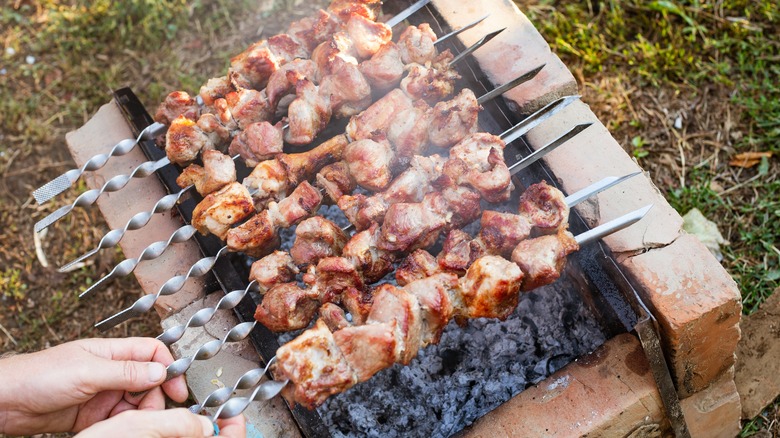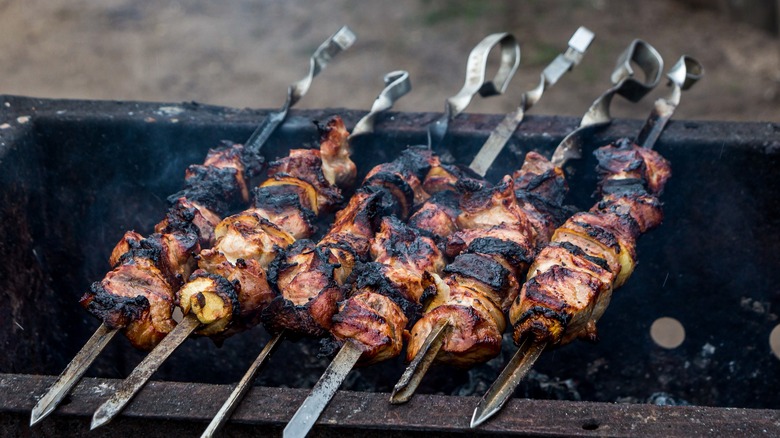When Grilling Meat Skewers, Your Setup Is Everything
A meat skewer is exactly what it sounds like. You take your choice of meat– chicken, beef, whatever you like– and stick it on a long wooden or metal skewer. If you're feeling really wild, you can actually add some peppers, onions, and other vegetables onto the skewer. The point is, a meat skewer isn't a very hard dish to assemble at all and can be cooked on either the grill or in your stove.
But what do we mean by "setup?" What we're referring to is how you set up your grill. It's not hard to see how you can think anyone could mess up grilling a meat skewer, considering all you do is lay the skewer on the grill and turn it so all the sides get browned. While this is a tried-and-true method that has no doubt made plenty of delicious skewers and kebabs, what you should focus on is setting up a specialized "kebab rig" to cook your skewers on.
You don't need anything fancy– all you really need are some bricks, some aluminum foil, and some good old ingenuity. First, take the bricks and wrap them up in a layer or two of aluminum foil. Then, lay the bricks on top of or inside your grill, giving each brick about 10 to 12 inches of space between them. This may seem pretty unorthodox at first, but this process actually gives you a better kebab or skewer without burning them or dirtying them up with soot.
This setup helps to channel heat more effectively
So now you're standing in front of your grill, looking at these aluminum foil bricks. The one question you're probably asking yourself is: "What does building a platform of bricks have to do with making skewers?" This setup may not be as easy as laying your skewers down on the grill, but it does have its benefits.
By laying the skewers between the bricks, as if you were building a floor of skewers, what you're actually doing is exposing the meat and vegetables to a direct "channel" of heat. By a process known in firefighting as the "chimney effect," heat and other gases rise in an enclosed vertical space like an air duct, a chimney, or in this case, the space between your bricks. While this chimney effect is no doubt dangerous when uncontrolled, the use of these bricks allows heat to better rise up to your skewers, where the meat and vegetables will be cooked much more efficiently than laying them against the grill itself. Another bonus is that your meat won't get any wayward soot or debris left on the grill, since it's suspended above the surface of the grill and the fire itself.
Even if the grills are being exposed to a channel of constant heat, it's still important to follow one simple, basic rule of grilling: turning. The difference between a poor skewer and a good skewer is how often you turn them.
Turn your meat skewers very often
Imagine a hamburger that hasn't been flipped or a pancake only allowed to cook on one side. The end results are less than ideal, and much like the pancake or hamburger, one of the secrets to success of the skewer is to know when and how often to turn or flip them.
A good rule of thumb to keep in mind is that you should turn your skewers every two minutes or so, paying careful attention to how much time one side is exposed to the heat. If you have more delicate ingredients on the skewer, you may want to flip them somewhat faster to prevent one side from cooking too fast. If you have tougher ingredients, you don't have to flip them as often. The key is always giving each side of the skewer heat, so it's less about frantically turning them as it is keeping all sides even.
Of course, you may also need to make minute adjustments, such as adjusting the flame or replacing finished skewers with raw ones. If you're having trouble constantly adjusting and turning, you may also want someone else to help you while you prepare them. So long as the skewers or kebabs are kept over the chimney of heat and being rotated at constant intervals, your skewers will come out perfect every time.


